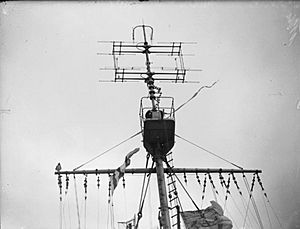Type 281 radar facts for kids
| Country of origin | United Kingdom |
|---|---|
| Introduced | 1940 |
| No. built | 59 |
| Type | Early-warning radar |
| Frequency | 86–94 MHz |
| PRF | 50 per second |
| Beamwidth | 35° (horizontal) |
| Pulsewidth | 2–3 μs or 15 μs |
| Range | 115 nmi (213 km; 132 mi) |
| Altitude | 30,000 feet (9,100 m) |
| Power | 350 kW–1 MW |
The Type 281 radar was a special British radar system. It was created for the navy during World War II. This radar was very important because it helped ships find enemy planes and ships from far away. It took over from an older radar, the Type 79, and became the main radar for the Royal Navy during the war.
Contents
How the Type 281 Radar Worked
A radar works by sending out radio waves. These waves bounce off objects like planes or ships. Then, the radar's receiver catches the bounced waves. By measuring how long it takes for the waves to return, the radar can figure out how far away an object is.
Early Models and Testing
The very first Type 281 radar was put on a ship called HMS Dido. This happened in October 1940. This early radar used radio waves at a certain frequency (90 MHz). It also had a wide beamwidth (35°), which is like how wide its "view" was.
This first version needed two separate parts: one to send the waves and one to receive them. Sailors had to turn these parts by hand.
Finding Targets from Afar
For finding targets far away, like aircraft, the radar sent out a long pulse of energy. This pulse lasted for 15 microseconds. It was very powerful, using 350 kilowatts of energy. This allowed it to detect aircraft up to 110 nautical miles (200 km; 130 mi) away.
To track ships on the water, it used a shorter, more powerful pulse. This pulse lasted only 2–3 microseconds but used 1 megawatt of power. This gave it a range of up to 12 nautical miles (22 km; 14 mi) for surface targets.
Improving the Radar
In January 1941, another Type 281 radar was put on the battleship HMS Prince of Wales. After this, 57 more sets were made and delivered quickly. These newer radars could also help with aiming ship guns. They had a special "Precision Ranging Panel." This panel helped sailors measure distances very accurately.
For example, it could show distances from 2,000 yards (1,830 m) to 14,000 yards (12,800 m) or even up to 25,000 yards (22,860 m). The radar was quite precise, with an accuracy of about 50 yards (50 m) or 75 yards (70 m). The distances to enemy aircraft were sent directly to the ship's fire control computer, called the HACS table. This helped the guns aim correctly.
Different Versions of Type 281
Over time, the Type 281 radar was improved with different versions.
Type 281B and 281BP
The Type 281B version made things simpler. It combined the sending and receiving parts into one antenna. The Type 281BP version was similar but did not have the short-pulse feature.
These improved radars had better receivers. This meant they could detect aircraft even further away. An aircraft flying at 20,000 feet (6,100 m) could be seen up to 120 nautical miles (220 km; 140 mi) away. At lower heights, the range was less. For example, at 10,000 feet (3,050 m), the range was 90 nautical miles (170 km; 100 mi), and at 5,000 feet (1,520 m), it was 65 nautical miles (120 km; 75 mi).
Type 281BQ
The Type 281BQ was another upgrade. It was a Type 281BP but with a new feature: power rotation. This meant the antenna could turn by itself at 2 or 4 revolutions per minute (rpm). It also had a plan position indicator. This was a screen that showed a map-like view of all the detected targets around the ship.
After World War II ended, the Type 281 radar was replaced by a newer system called the Type 960 radar.


